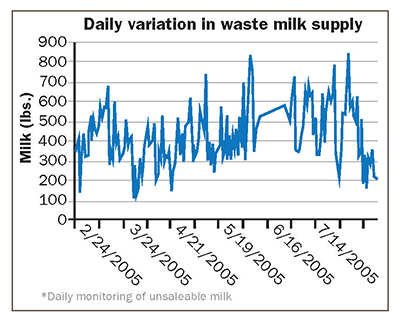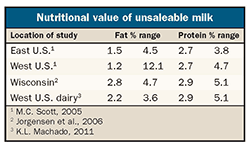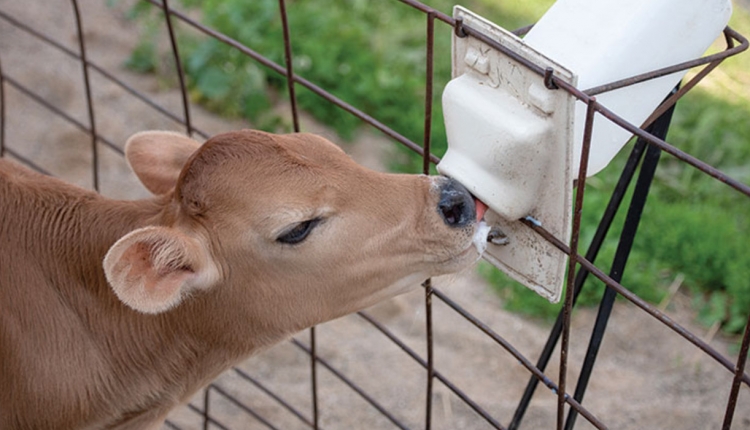The author is in the department of dairy science at Virginia Tech University in Blacksburg, Va.

Many dairies have adopted more progressive calf feeding programs where milk or milk replacer feeding rates have risen from 4 quarts per day to 8 quarts or more per day. The cash outlay for milk replacer (particularly those high-quality ones formulated for biologically normal feeding rates) has caused some producers to consider incorporating the use of unsaleable milk (USM) into their calf feeding programs.
Usually, USM is obtained from the second and greater milking that is not suitable for sale and also from cows treated with antibiotics. Before making the decision to replace a high-quality milk replacer with USM, several important factors should be considered and questions answered.
Remember that the calf is a young animal with a developing immune system that is very susceptible to respiratory and digestive disease. Risks involved in feeding USM must be considered when developing successful feeding programs for this young animal.
For starters, USM can be a source of pathogenic bacteria. This can be particularly problematic in farms purchasing animals of unknown health status. Several important diseases can be transmitted to calves during this early milk feeding period.
In addition to specific disease agents, consumption of milk with high bacteria counts is probably not conducive to calf health during the first few weeks of life when the bacterial flora of the young calf is very unstable. Failure to adequately clean storage vessels or insufficient cooling of USM results in rapid bacterial growth and deterioration of milk quality. Aerobic bacteria counts from raw USM samples in several field trials were found to vary between a low of 5,000 cfu/mL to over 100,000,000 cfu/mL.
In addition, antibiotics from treated cows have an unknown impact on the normal bacterial flora of the calf, particularly in one less than 2 weeks of age.
The nutrient content of USM also varies tremendously. Field studies conducted in North Carolina, California and Wisconsin found wide variations in fat and protein content, as shown in the table. This happened for a variety of reasons, including inadvertent addition of water to USM and poor agitation during storage.

Most farms experience a large daily or weekly variation in supply of waste milk. One 1,200-plus cow dairy in the eastern U.S. (see figure) found that daily production of USM varied from a low of 100 pounds to a high of over 800 pounds per day. Production of USM did not correlate well with the demand of USM for their calf feeding program.
How much USM should a farm produce on a daily basis? A plentiful supply of USM should not be viewed as an abundant source of calf feed but a loss of potential milk income. Marketing milk with low SCC should be a goal of every progressive dairy producer. This is achieved in two ways: 1) instituting managed milking programs which foster production of low SCC milk; 2) withholding milk from high SCC cows. The latter example results in lost income and incurs higher expenses as the production costs per cwt. (hundredweight) of milk withheld from sales must be absorbed by the remaining milk sold.
Unsaleable milk should never be fed raw due to the risk of transmitting infectious diseases to the calves. Milk from cows possibly infected with Johne's and BVD (bovine viral diarrhea) is especially of concern. Fortunately, there are many pasteurizers suitable for on-farm use that have proven to reliably treat USM. These are either batch or high temperature short time (HTST) pasteurizers. Batch pasteurizers are required to heat milk to 145°F and hold it for at least 30 minutes, while the HTST units achieve this by heating milk to 161°F for 15 seconds.
It is important to note that only when pasteurizers are correctly installed and maintained will they "kill" 98 to 99 percent of the bacteria. Pasteurization is generally considered to be successful when postpasteurization counts are 20,000 cfu/mL or less. Therefore, bacteria counts prior to pasteurization should not exceed 2,000,000 cfu/mL.

Basic protocols must be followed to achieve consistent, successful pasteurization. Thoroughly clean all surfaces that come in contact with USM, including milking equipment, lines, hoses and storage containers.
Ideally, USM should be harvested, pasteurized and fed to calves in as short a time as possible to prevent growth of bacteria. One must follow identical protocols that are used for saleable milk to limit bacterial growth.
The first decision to make regarding use of USM as a feed for the calf feeding program is to determine the true cost of owning and operating a pasteurizer. In addition to purchase cost, one must also consider installation cost, including electrical and plumbing expense and provision of a source of adequate hot water for HTST systems. Estimate additional expense for labor and electricity or gas to operate the pasteurizer and/or hot water heater.
Pasteurizer function must be routinely monitored by measuring bacterial counts after pasteurization and by sampling milk fed to the last calf on at least a monthly basis. State or cooperative labs can provide these services. Several spreadsheets are also available to aid in estimating the cost of the milk feeding system: http://extension.psu.edu/animals/dairy/nutrition/calves or http://www.vtdairy.dasc.vt.edu/tools/tool-data.html.
Many dairies have successfully incorporated use of pasteurized USM into their calf feeding programs. However, the first decision is to carefully consider the true cost of these systems relative to feeding milk replacer. If a pasteurizer is implemented, meticulous care must be taken to manage it successfully.
This article appears on page 335 of the May 10, 2015 issue of Hoard's Dairyman.
Return to the Hoard's Dairyman feature page.

Many dairies have adopted more progressive calf feeding programs where milk or milk replacer feeding rates have risen from 4 quarts per day to 8 quarts or more per day. The cash outlay for milk replacer (particularly those high-quality ones formulated for biologically normal feeding rates) has caused some producers to consider incorporating the use of unsaleable milk (USM) into their calf feeding programs.
Usually, USM is obtained from the second and greater milking that is not suitable for sale and also from cows treated with antibiotics. Before making the decision to replace a high-quality milk replacer with USM, several important factors should be considered and questions answered.
Think of the calf
Remember that the calf is a young animal with a developing immune system that is very susceptible to respiratory and digestive disease. Risks involved in feeding USM must be considered when developing successful feeding programs for this young animal.
For starters, USM can be a source of pathogenic bacteria. This can be particularly problematic in farms purchasing animals of unknown health status. Several important diseases can be transmitted to calves during this early milk feeding period.
In addition to specific disease agents, consumption of milk with high bacteria counts is probably not conducive to calf health during the first few weeks of life when the bacterial flora of the young calf is very unstable. Failure to adequately clean storage vessels or insufficient cooling of USM results in rapid bacterial growth and deterioration of milk quality. Aerobic bacteria counts from raw USM samples in several field trials were found to vary between a low of 5,000 cfu/mL to over 100,000,000 cfu/mL.
In addition, antibiotics from treated cows have an unknown impact on the normal bacterial flora of the calf, particularly in one less than 2 weeks of age.
The nutrient content of USM also varies tremendously. Field studies conducted in North Carolina, California and Wisconsin found wide variations in fat and protein content, as shown in the table. This happened for a variety of reasons, including inadvertent addition of water to USM and poor agitation during storage.

A steady supply needed
Most farms experience a large daily or weekly variation in supply of waste milk. One 1,200-plus cow dairy in the eastern U.S. (see figure) found that daily production of USM varied from a low of 100 pounds to a high of over 800 pounds per day. Production of USM did not correlate well with the demand of USM for their calf feeding program.
How much USM should a farm produce on a daily basis? A plentiful supply of USM should not be viewed as an abundant source of calf feed but a loss of potential milk income. Marketing milk with low SCC should be a goal of every progressive dairy producer. This is achieved in two ways: 1) instituting managed milking programs which foster production of low SCC milk; 2) withholding milk from high SCC cows. The latter example results in lost income and incurs higher expenses as the production costs per cwt. (hundredweight) of milk withheld from sales must be absorbed by the remaining milk sold.
Pasteurization a must
Unsaleable milk should never be fed raw due to the risk of transmitting infectious diseases to the calves. Milk from cows possibly infected with Johne's and BVD (bovine viral diarrhea) is especially of concern. Fortunately, there are many pasteurizers suitable for on-farm use that have proven to reliably treat USM. These are either batch or high temperature short time (HTST) pasteurizers. Batch pasteurizers are required to heat milk to 145°F and hold it for at least 30 minutes, while the HTST units achieve this by heating milk to 161°F for 15 seconds.
It is important to note that only when pasteurizers are correctly installed and maintained will they "kill" 98 to 99 percent of the bacteria. Pasteurization is generally considered to be successful when postpasteurization counts are 20,000 cfu/mL or less. Therefore, bacteria counts prior to pasteurization should not exceed 2,000,000 cfu/mL.

Basic protocols must be followed to achieve consistent, successful pasteurization. Thoroughly clean all surfaces that come in contact with USM, including milking equipment, lines, hoses and storage containers.
Ideally, USM should be harvested, pasteurized and fed to calves in as short a time as possible to prevent growth of bacteria. One must follow identical protocols that are used for saleable milk to limit bacterial growth.
Penciling it out
The first decision to make regarding use of USM as a feed for the calf feeding program is to determine the true cost of owning and operating a pasteurizer. In addition to purchase cost, one must also consider installation cost, including electrical and plumbing expense and provision of a source of adequate hot water for HTST systems. Estimate additional expense for labor and electricity or gas to operate the pasteurizer and/or hot water heater.
Pasteurizer function must be routinely monitored by measuring bacterial counts after pasteurization and by sampling milk fed to the last calf on at least a monthly basis. State or cooperative labs can provide these services. Several spreadsheets are also available to aid in estimating the cost of the milk feeding system: http://extension.psu.edu/animals/dairy/nutrition/calves or http://www.vtdairy.dasc.vt.edu/tools/tool-data.html.
Many dairies have successfully incorporated use of pasteurized USM into their calf feeding programs. However, the first decision is to carefully consider the true cost of these systems relative to feeding milk replacer. If a pasteurizer is implemented, meticulous care must be taken to manage it successfully.










